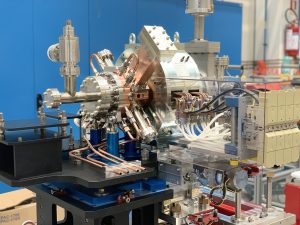 Within the collaboration between LNF and CERN, a new electron source for the CLEAR project has been designed and realized.
Within the collaboration between LNF and CERN, a new electron source for the CLEAR project has been designed and realized.
This source is based on a photocathode that, illuminated with laser pulses, generates electrons by photoelectric effect. The emitted electrons are immediately accelerated by very intense electric fields (larger than 100 MV/m) which are confined in copper cavities (electron guns) and generated by radiofrequency pulses. To realize these devices, it has been used a new technology developed and patented by LNF that substitutes the standard brazing procedures with special junctions based on vacuum-RF gaskets.
The brazing process consists in joining different copper structures by melting copper alloys at high temperatures (800-1000°C) and requires expensive vacuum furnaces. Moreover, annealed materials loose, partially, their properties in term of hardness, mechanical strength and capability of sustaining high surface electric fields. The new technology we developed allows to avoid these procedures, reducing costs and preserving the properties of the forged copper. By means of this technique other electron sources have already been realized at LNF, and CERN has decided to adopt it for the new source of the CLEAR project.
The electron beams generated by these sources show extremely high qualities in terms of brilliance, and are used at CERN in different type of experiments: X band accelerating test for future colliders, plasma acceleration, medical applications and irradiation tests.
 INFN-LNF Laboratori Nazionali di Frascati
INFN-LNF Laboratori Nazionali di Frascati